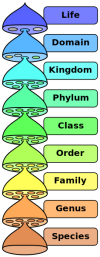 If
you a pre-college took a course in biology or zoology or botany
or entomology, etc., you already know about classification, unless
you always slept through class. Whether life
forms are extant or extinct (and, of course far and away most species
that ever lived across geologic time are now extinct), they are
biologically classified. Biological (scientific classification
of life) has been ungoing unabated for what is approaching three
centuries classification. Carolus Linnaeus deserves special mention
for his work in the 18th century grouping species
according
to shared physical/morphological traits and characteristics. For
example, his Systema Naturae (cover shown to left) was first printed
in 1735 with 12 pages. If
you a pre-college took a course in biology or zoology or botany
or entomology, etc., you already know about classification, unless
you always slept through class. Whether life
forms are extant or extinct (and, of course far and away most species
that ever lived across geologic time are now extinct), they are
biologically classified. Biological (scientific classification
of life) has been ungoing unabated for what is approaching three
centuries classification. Carolus Linnaeus deserves special mention
for his work in the 18th century grouping species
according
to shared physical/morphological traits and characteristics. For
example, his Systema Naturae (cover shown to left) was first printed
in 1735 with 12 pages. Its
its 10th edition published in 1758 classified some 4,400 animal
species and 7,700 plant species. His approach
laid the foundation, which
a century later became more
sophisticated as classification was guided by Darwin's
concept
of common descent by means of natural selection (evolution), even
though the discovery of the molecular biology behind it based on
DNA
was still long in the future. One should always bear in mind that
nothing in biology makes since except in the light of evolution. Its
its 10th edition published in 1758 classified some 4,400 animal
species and 7,700 plant species. His approach
laid the foundation, which
a century later became more
sophisticated as classification was guided by Darwin's
concept
of common descent by means of natural selection (evolution), even
though the discovery of the molecular biology behind it based on
DNA
was still long in the future. One should always bear in mind that
nothing in biology makes since except in the light of evolution.
The
image to the right depicts the hierarchical classification schemes
used today that has eight major taxonomic ranks, beginning
with "all life" at the top, and decending down to individual species
(both extinct and extant).
|